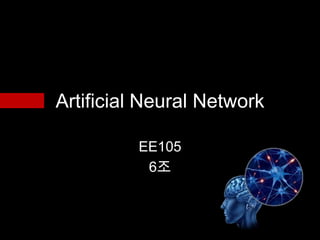
KAIST 2012 Fall 전자공학개론 6조 발표 PPT
- 1. Artificial Neural Network EE105 6조
- 2. Artificial Neural Network (ANN) • A mathematical model inspired by biological neural networks • ANN consists of an interconnected group of artificial neurons ▶
- 3. Compare to Brain Biological Neural Network Artificial Neural Network Neuron Unit (or node) Synapse Connection Inhibition or Excitation of Neuron Connection Weight Threshold of firing rate Activation Function
- 4. ANN Structure ANN BNN Input Layer Sensory Neurons Hidden Layer Interneurons Output Layer Motoneurons
- 5. Attractions of ANN Model • Learning – Human brain can learn by changing their interconnections between neurons – ANN can learn by changing their connection weights between units • Parallel Processing : Many processes simultaneously • Robustness: It works even if it is damaged
- 6. How to Work? Unit 1 Unit Unit 2 Unit … Unit Unit n
- 7. Example – AND Operator Unit 1 Unit 3 Unit 2 X f(X) Y 0 0 0 0 0 0 1 0.5 0.5 0 1 0 0.5 0.5 0 1 1 1 1 1
- 8. Example – OR Operator Unit 1 Unit 3 Unit 2 X f(X) Y 0 0 0 0 0 0 1 0.5 0.5 1 1 0 0.5 0.5 1 1 1 1 1 1
- 9. Example – XOR Operator Unit Unit 1 3 Unit 5 Unit Unit 2 4 Unit 1 Unit 2 Unit 5 X f(X) Y 0 0 0 0 0 0 1 0.5 0.5 1 1 0 0.5 0.5 1 1 1 0 0 0
- 10. How to Learn? 1. Set all connection weight as randomly 2. Input the data 3. If the output corrects (expected value) ▷ Then, exit iteration ▷ Else, change the connection weights to reduce difference and repeat (go to 2) How to change connection weight? There are many algorithms but is hard to explain because of the margin of the slide is too small!!
- 11. Applications • Pattern Recognition – Voice Recognition – Medical Treatment (e.g. cancer detect) • Data Processing – Noise Filtering • Robotics – Data-Driven Predictive Controller
- 12. Any Questions? Thank you